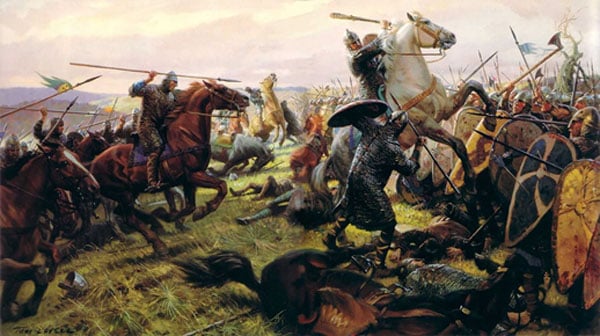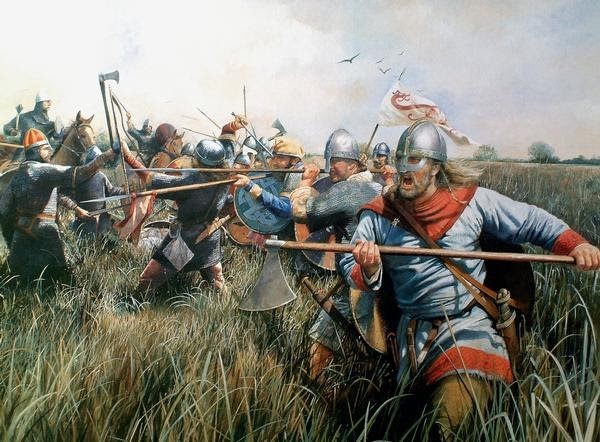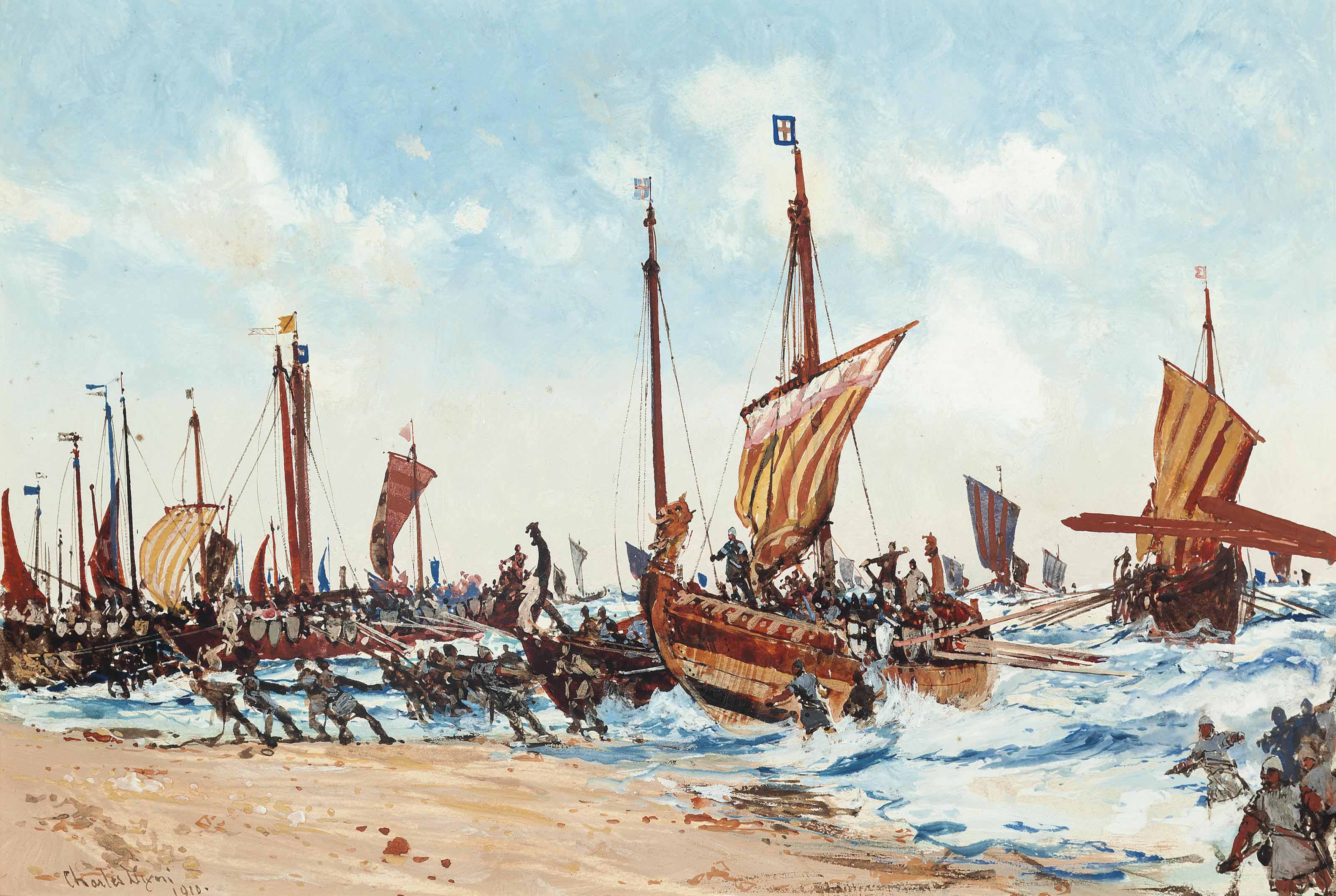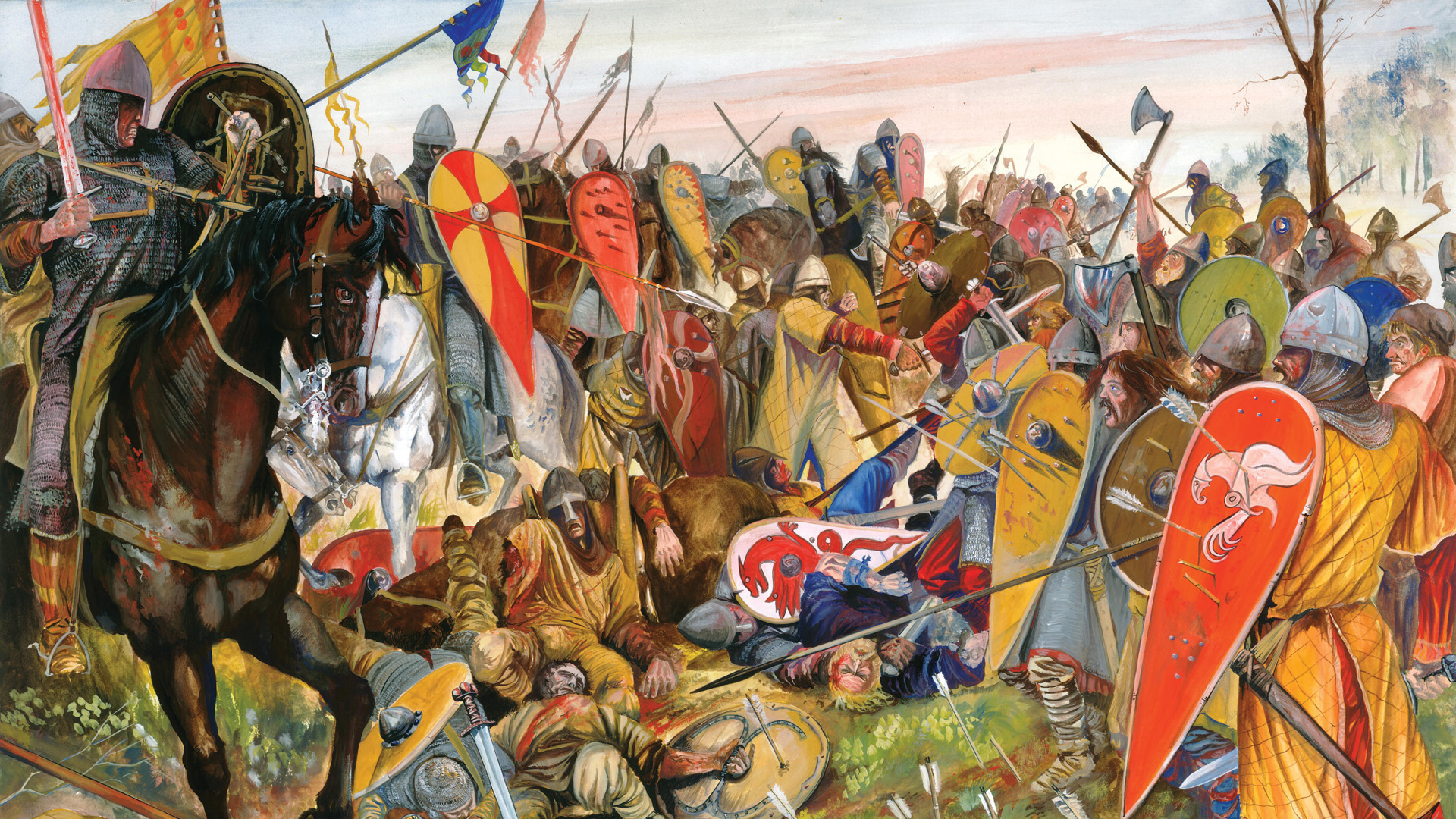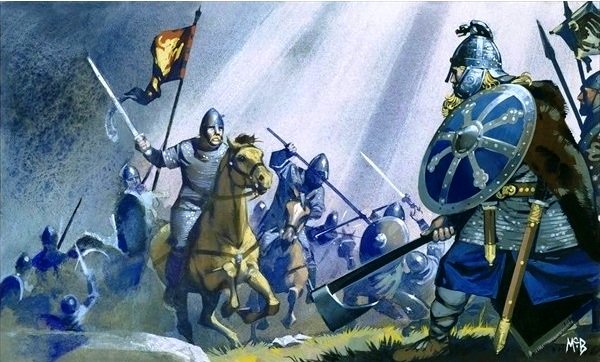Chapter I
An Affair of Norman Proportions
The man, known to history as King Richard I "One Eye" of England, was born on 18 July 1038, in what is today the city of Angers, France. Richard was the illegitimate child of Robert I The Magnificent, Duke of Normandy, and Ermengarde Ingelger, Countess of Anjou. The famous tale describes a clandestine meeting between the two as children, and a promise to marry one another when they came of age, but political machinations kept them from fulfilling their promises, and an extramarital affair between the two led to Richard's birth. The truth of the matter is perhaps a little more mundane. Duke Robert was a full 18 years older than Ermengarde, and the two hadn't met before 1036 when Ermengarde came of age at 16. It is believed that 1036 is the latest date from which both could have met for the first time, as Henry I, King of the Franks, held special ceremonies during that timeframe, inviting all subjects and vassals to his tournaments and banquets.
Robert of Normandy was the direct descendent of Rollo of Normandy, the Viking invader that was settled on the Northern shores of France in the Mid-10th Century. Ermengarde, on the other hand, was the daughter of Fulk III "The Black", the Count of Anjou from 987 until he died in 1040, from which his county was handed down to his only surviving daughter. It would have been given to Ermengarde's brother Geoffrey, had he not died tragically in 1034 of an undisclosed illness, possibly Tuberculosis. Ermengarde herself was first betrothed to Geoffrey II, Count of Gâtinais in 1035, and they married the next year.
Not much is known about Robert's marriage, on the other hand. It is understood that he was married before his late 20s, but never bore any children. It is believed that Robert never consummated his marriage for various reasons. It is known however that Robert was a loyal subject of King Henry, sheltering him from his mother and younger brother (also known as Robert I "The Old", Duke of Burgundy) in 1030 until a compromise could be worked out between the family. For his loyalty, Robert was granted more land in Northern France, primarily the county of Vexin. It is not known when exactly Robert and Ermengarde eloped in a lascivious affair, but when it became apparent that Ermengarde was pregnant, the scandal was exposed.
Ermengarde soon after divorced her husband, Geoffrey, and Robert would be granted an annulment for his, and the two married in late 1038, months after Richard was born. Not much is known exactly about Richard's childhood. It is understood that he was given a normal education in line with noble families of the era but found a special interest in warfare and military tactics. Richard was also legitimized by both Robert and Ermengarde after his 10th birthday in 1048. Sadly, Robert would die of a disease in 1050, leaving the 12-year-old Richard in a dangerous position. A minor in a position of power in the Medieval world always laid the groundwork for dangerous possibilities, as there would be many competing factions vying for dominance and influence over the young man.
Chapter 2
The One-Eyed Duke
(Portrait of Richard I "One-Eye" de Normangevin c. 1059)
Perhaps the most influential of those who would look over the young Duke was Richard, Count of Evreux. For this documentary, we shall refer to this Richard as Richard of Evreux. Richard of Evreux was already in his mid-60s and had served Duke Robert faithfully for many years by this point. He would exert the most influence of anyone on young Richard, and it was in large part thanks to his guidance, that young Richard was able to survive to adulthood and exert his power over his duchy of Normandy. Indeed, Richard of Evreux was highly trusted by young Richard; and it is no small wonder as Count Richard of Evreux was already the most powerful vassal of Robert, and that continued well into Richard's reign. Richard of Evreux would receive several titles later on in Richard's reign, most notably the title of "Ducal Regent" during matters from where Richard would be absent from his realm.
Additionally, as the primary heir of the County of Anjou, he inherited the title from his mother in 1055, following the death of his mother Countess Ermengarde. In 1056, Richard finally arrived in Vermandois and paid homage to King Henry I of France. With that, he was finally in control of his realm, free from the shackles of regency. At age 18, Richard "One Eye" was now able to do as he pleased.
Richard himself was known to be a gregarious man, holding many social events during his early reign in the 1050s; he was of average height but carried an imposing physique, with a strong, clear voice, and long brown hair that went down to his shoulders. He also was possessed of a pronounced jaw, and piercing blue eyes that were said to hold the fury of an army of angels. Perhaps the most important thing about Richard was his ambition; he knew an opportunity when he saw it, and wasn't afraid to take risks if he felt the positives outweighed the potential negatives. Of course, Richard was not without controversy, as many of his detractors would bring attention to his many faults as a person.
Richard carried with him an inflammatory temper, flaring up at any perceived slights; one episode was so bad, as the story goes, that he threw his shoes into a river and declared to a local cobbler that "Vous allez vous pendre par vos chaussures et vous noyer, par Dieu! [You will hang by your shoes and drown, by God!]" after the cobbler refused to help the young Duke when an argument ensued over Richard's payment to the cobbler. Richard's anger issues are likely what led to his alcoholism throughout his life. Additionally, later chroniclers have found implicit evidence of Richard having unorthodox tastes regarding sexuality. Among some of the epithets he was given by contemporaries was the nickname "Le Méchant Lubrique", which, translated into English, means "The Lustful Villain". Indeed, Richard made no secret that he enjoyed the company of a fine lady, but he never committed adultery, as far as we know, after becoming King of England in 1066.
Richard's epithet of "One Eye" occurred after a disease, hypothesized to be extremely early-onset macular degeneration, took away eyesight in his left eye; after being forced to wear an eyepatch afterward, it was believed one of Richard's childhood friends, Guilles de Bullion, jokingly called him "Richard Borgne". Borgne, of course, is French for "One-Eyed"; and thus the name stuck. For his Franco-Norman subjects, he was commonly called Richard Borgne; later on, during his reign as King of England, he would be known to the Anglo-Saxons as "Richard An Ēagan".
Chapter 3
The Other Kings of England
(Extent of Cnut the Great's Realm, 1028-1035)
Richard's claim to the English throne is a long and complicated tale; it originates from the crises of the early 1010s until the ascension of Edward the Confessor in 1042. Æthelred II the Unready, the King of England in 1013, fled to Normandy after the invasion of Sweyn Forkbeard, King of Denmark and Norway. Æthelred himself was married to Emma of Normandy(his second wife at the time), the sister of Richard's paternal grandfather Richard II "The Good", Duke of Normandy. In quick succession, Æthelred would take back the Kingdom from Sweyn, but died three years later in 1016; Edmund Ironside, Æthelred's eldest surviving son, inherited the English throne but died over seven months later after being defeated by Sweyn Forkbeard's son, Cnut The Great. Cnut reigned as King of England, Denmark, and Norway for the better part of 19 years. When Cnut died in 1035, Harold Harefoot inherited the English throne but died five years later in 1040. Harold's brother Harthacnut, King of Denmark, then took the English throne. However, when Harthacnut suddenly died in 1042, Æthelred The Unready's surviving son, and Harthacnut's Half-Brother (by Emma of Normandy's marriage to Cnut the Great) Edward the Confessor finally became the true King of England.
(St. Edward The Confessor, King of England 1042-1066)
However, during Edward the Confessor's exile from England, he primarily sheltered in Normandy, where he was very well acquainted with Robert I of Normandy. Both were First Cousins between one another, and they had struck up a long friendship that would last them the rest of Robert's life. In 1035, there was an attempt to restore the House of Wessex (Edward the Confessor's royal family) to the throne. Edward and Alfred Ætheling landed in Sussex with a small group of Norman bodyguards but were betrayed by a powerful Earl of the realm, Godwin, Earl of Wessex. Alfred Ætheling, Edward's brother, was captured and subsequently blinded by Godwin; he died sometime later of his grievous injuries. The story goes that Godwin blinded Alfred with red-hot pokers; a particularly gruesome way to die. Edward himself never forgave Godwin for this indignity, and King Harthacnut himself later prosecuted Godwin for the crime against his half-brother. Both Edward and Harthacnut considered Godwin guilty of the crime, but unsurprisingly, Godwin remained a powerful Earl for the rest of his life, despite facing exile twice throughout his tenure.
Alas, during the reign of Edward the Confessor, the Godwin family became much stronger, as Edward capitulated to them and gave them many powerful and influential titles throughout the Kingdom's realm. The matter of succession was heavily disputed throughout Edward's reign, however. Edward the Confessor never had children with his wife Edith Godwinson of Wessex (the daughter of Godwin of Wessex), either out of a sense of piety, or some other reason. During his exile in Normandy however, it is believed that Edward had promised his cousin Duke Robert of Normandy that he would inherit the English throne. When Robert died in 1050, Edward instead looked to Richard and offered him the right of succession in 1051. It is asserted that Edward did promise the throne to Richard Borgne; this was further solidified by a meeting between Richard and Edward's most powerful vassal: Harold Godwinson. In 1062, 12 years into Richard's tenure as the Duke of Normandy, Harold Godwinson shipwrecked at Pontheiu, whereby Richard offered to shelter Harold until he could safely return. The reason for Harold's journey is dubious and uncertain even to most modern historians. Norman chroniclers however agree with Richard's story that Harold came to affirm Edward's "promise" to Richard for the throne of England.
Chapter 4
A Betrayal, and Call to War
Of course, there would have been no real way for Edward the Confessor to promise the throne of England to Richard in such a fashion. The truth of the matter is that the power to affirm a successor and new king was the King's council, the Witenagemot; without their affirmation, no man could truly be proclaimed king. Nevertheless, Richard took these two incidents and ran with them, staking his rightful claim to the throne of England. However, Richard wasn't just the only contender for the throne of England...
In 1066, Edward the Confessor became sickly and would eventually die on 5 January 1066. One of the most controversial and consequential events that would happen then would be Harold Godwinson's claim that, with his dying breaths, Edward declared that England should go to Harold, and not Richard Borgne of Normandy. On the same day of Edward's funeral, Harold Godwinson was crowned King of England on 6 January 1066. It was an affront to everything that had been established years beforehand in the eyes of Richard Borgne. After all, twice he had been affirmed by Edward the Confessor as the true heir apparent to the English throne. Harold had even sworn "on holy relics" to Richard's claim in 1062! This was tantamount to treason, and when Richard heard of this betrayal, he declared, "Je serai roi d'Angleterre, et Harold sera pendu par le cou, au nom de Dieu! [I will be king of England, and Harold will be hanged by the neck, in the name of God!]".
Before Richard could press his claim through warfare, he first had to attain support for his claim. Richard acquired consent from Pope Alexander II to invade England in mid-1066. According to the chronicler William of Poitiers, Richard then attained support for his claim from the King of Germany, Italy, & Burgundy, Henry IV, the future Holy Roman Emperor, and another pretender to the English throne, Danish King Sweyn II. Sweyn II was the grandson of Sweyn Forkbeard, and by right, had a legitimate familial claim to the English crown. However, it should be noted that conflicting reports of Sweyn's support for Richard did exist, as Sweyn's support was perhaps given to another pretender...
The King of Norway, Harald Hardrada, claimed a right to the English throne citing the recent Anglo-Danish wars for the crown. Hardrada originally vied for Sweyn II's crown of Denmark, but a compromise was made between the two, and Harald instead turned his attention to England. Hardrada had a largely fulfilling life, have been a member of the Byzantine Empire's Varangian Guard; Harald Hardrada battled all across the Eastern Mediterranean. Asia Minor, Sicily, the Levant, Bulgaria, and Constantinople itself, he was by far the most experienced military commander of all contenders for the Kingdom of England. Additionally, Harold Godwinson's brother, Tostig Godwinson, Earl of Northumbria, formally swore allegiance to Harald, and would become Hardrada's partner in his military campaign for the English throne.
With this, the scene was set. The history of Europe would change from this moment onwards, and a great battle for the future of England would commence. In September of 1066, Harold Godwinson's English army, Harald Hardrada's Norwegian army, and Richard "Borgne" de Normangevin's Norman army would clash with one another for the English throne. This would come to be known to history, as the "Anglo-Danish-Norman War". |





